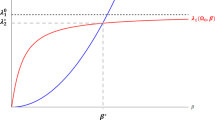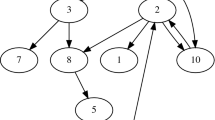Abstract
In this paper we show how the spatialconfiguration of habitat quality affects the spatial spread of apopulation in a heterogeneous environment. Our main result is thatfor species with limited dispersal ability and a landscape withisolated habitats, stepping stone patches of habitat greatlyincrease the ability of species to disperse. Our results showthat increasing reproductive rate first enables and thenaccelerates spatial spread, whereas increasing the connectivity has aremarkable effect only in case of low reproductive rates. Theimportance of landscape structure varied according to thedemographic characteristics of the population. To show this wepresent a spatially explicit habitat model taking into accountpopulation dynamics and habitat connectivity. The population dynamicsare based on a matrix projection model and are calculated on eachcell of a regular lattice. The parameters of the Leslie matrix dependon habitat suitability as well as density. Dispersal between adjacentcells takes place either unrestricted or with higher probability inthe direction of a higher habitat quality (restricted dispersal).Connectivity is maintained by corridors and stepping stones ofoptimal habitat quality in our fragmented model landscape containinga mosaic of different habitat suitabilities. The cellular automatonmodel serves as a basis for investigating different combinations ofparameter values and spatial arrangements of cells with high and lowquality.
Similar content being viewed by others
References
Adler G.H. and Wilson M.L. 1985. Small mammals on Massachusetts islands: the use of probability functions in clarifying biogeographic relationships. Oecologia 66: 178-186.
Akçakaya H.R. and Atwood J.L. 1997. A habitat-based metapopulation model of the california gnatcatcher. Conserv. Biol. 11: 422-434.
Akçakaya H.R., McCarthy M.A. and Pearce J.L. 1995. Linking landscape data with population viability analysis: management options for the helmeted honeyeater Lichenostomus melanops cassidix. Biol. Conserv. 73: 169-176.
Amarasekare P. 1998. Interactions between local dynamics and dispersal: insights from single species models. Theor. Popul. Biol. 53: 44-59.
Andrén H. 1994. Effects of habitat fragmentation on birds and mammals in landscapes with different proportions of suitable habitat: a review. Oikos 71: 355-366.
Appelt M. and Poethke H.J. 1997. Metapopulation dynamics in a regional population of the blue-winged grasshopper Oedipoda caerulescens; Linnaeus, 1758. J. Insect Conserv. 1: 205-214.
Bascompte J. and Solé R.V. (eds) 1998. Modeling Spatiotemporal Dynamics in Ecology. Springer, Berlin, Germany.
Botsford L.W. 1996. Dynamics of populations with density-dependent recruitment and age structure. In: Tuljapurkar S. and Caswell H. (eds), Structured-Population Models in Marine, Terrestrial, and Freshwater Systems. Chapman and Hall, New York, NY, USA, pp. 371-408.
Bowne D.R., Peles J.D. and Barrett G.W. 1999. Effects of landscape spatial structure on movement patterns of the hispid cotton rat Sigmodon hispidus. Landscape Ecol. 14: 53-66.
Brooker L., Brooker M. and Cale P. 1999. Animal dispersal in fragmented habitat: measuring habitat connectivity, corridor use, and dispersal mortality. Cons. Ecol. 3.
Burgman M.A., Ferson S. and Akçakaya H.R. 1993. Risk Assessment in Conservation Biology. Chapman and Hall, London, UK.
Cantwell M.D. and Forman R.T.T. 1993. Landscape graphs: Ecological modeling with graph theory to detect configurations common to diverse landscapes. Landscape Ecol. 8: 239-255.
Caswell H. 1989. Matrix Population Models-Construction, Analysis, and Interpretation. Sinauer Associates Inc., Sunderland, Massachusetts, USA.
Caswell H. 1996. Matrix methods in population analysis. In: Tuljapurkar S. and Caswell H. (eds), Structured-Population Models in Marine, Terrestrial, and Freshwater Systems. Chapman and Hall, New York, NY, USA, pp. 19-58.
Czárán T. 1998. Spatiotemporal Models of Population and Community Dynamics. Chapman and Hall, London, UK.
Czárán T. and Iwasa Y. 1998. Spatiotemporal models of population and community dynamics. Trends Ecol. Evol. 13: 294-295.
DeAngelis D.L. 1988. Strategies and difficulties of applying models to aquatic populations and food webs. Ecol. Model. 43: 57-73.
Di Cola G., Gilioli G. and Baumgärtner J. 1999. Mathematical models for age-structured population dynamics. In: Huffaker C.B. and Gutierrez A.P. (eds), Ecological Entomology. John Wiley & Sons, New York, NY, USA, pp. 503-536.
Doak D.F., Marino P.C. and Kareiva P.M. 1992. Spatial scale mediates the influence of habitat fragmentation on dispersal success: Implications for conservation. Theor. Popul. Biol. 41: 315-336.
Dunning J.B., Stewart D.J., Danielson B.J., Noon B.R., Root T.L., Lamberson R.H. et al. 1995. Spatially explicit population models: Current forms and future uses. Ecol. Appl. 5: 3-11.
Fahrig L. 1991. Simulation methods for developing general landscape-level hypotheses of single-species dynamics. In: Turner M.G. and Gardner R.H. (eds), Quantitative Methods in Landscape Ecology-The Analysis and Interpretation of Landscape Heterogeneity. Springer, New York, NY, USA, pp. 417-442.
Fahrig L. 1998. When does fragmentation of breeding habitat affect population survival? Ecol. Model 105: 273-292.
Gardner R.H., O’Neill R.V. and Turner M.G. 1993. Ecological implications of landscape fragmentation. In: McDonnell M.J. and Pickett S.T.A. (eds), Humans as Components of Ecosystems-The Ecology of Subtle Human Effects and Populated Areas. Springer, New York, NY, USA, pp. 208-226.
Gardner R.H., O’Neill R.V., Turner M.G. and Dale V.H. 1989. Quantifying scale-dependent effects of animal movement with simple percolation models. Landscape Ecol 3: 217-227.
Griebeler E.M. and Gottschalk E. 2000. An individual based model of the impact of suboptimal habitat on survival of the grey bush cricket, Platycleis albopunctata (Orthoptera: Tettigoniidae). J. Insect Conserv. 4: 225-237.
Gustafson E.J. 1998. Quantifying landscape spatial pattern: what is the state of the art? Ecosystems 1: 143-156.
Hanski I., Pakkala T., Kuussaari M. and Lei G. 1995. Metapopulation persistence of an endangered butterfly in a fragmented landscape. Oikos 72: 21-28.
Henein K. and Merriam G. 1990. The elements of connectivity where corridor quality is variable. Landscape Ecol. 4: 157-170.
Hosmer D.W. and Lemeshow S. 1989. Applied Logistic Regression. Wiley, New York, NY, USA, 307 pp.
Hughes T.P. and Connell J.H. 1987. Population dynamics based on size or age? A reef coral analysis. Am. Nat. 129: 818-829.
Ingrisch S. and Köhler G. 1998. Die Heuschrecken Mitteleuropas. Westarp Wissenschaften, Magdeburg, Germany.
Jeltsch F., Milton S.J., Dean W.R.J., van Rooyen N. and Moloney K.A. 1998. Modelling the impact of small-scale heterogeneities on tree-grass coexistence in semi-arid savannas. J. Ecol. 86: 780-793.
Kareiva P.M. 1990. Population dynamics in spatially complex environments: theory and data. Phil. Trans. R. Soc. Lond. B 330: 175-190.
Keitt T.H., Urbam D.L. and Milne B.T. 1997. Detecting critical scales in fragmented landscapes. Cons. Ecol. 1.
Kleyer M., Kratz R., Lutze B. and Schröder B. 1999/2000. Habitatmodelle für Tierarten: Entwicklung, Methoden und Perspektiven für die Anwendung. Z. Ökologie u. Naturschutz 8: 177-194.
Law R. and Edley M.T. 1990. Transient dynamics of populations with age-and size-dependent vital rates. Ecology 71: 1863-1870.
Lefkovitch L.P. 1965. The study of population growth in organisms grouped by stages. Biometrics 21: 1-18.
Leslie P.H. 1945. On the use of matrices in certain population mathematics. Biometrika 33: 183-212.
Letcher B.H., Priddy J.A., Walters J.R. and Crowder L.B. 1998. An individual-based, spatially-explicit simulation model of the population dynamics of the endangered red-cockaded woodpecker, Picoides borealis. Biol. Conserv. 86: 1-14.
Lindenmayer D.B. and Possingham H.P. 1996. Modelling the inter-relationships between habitat patchiness, dispersal capability and metapopulations persistence of the endangered species, Leadbeater’s possum, in south-eastern Australia. Landscape Ecol. 11: 79-106.
McIntyre N.E. and Wiens J.A. 1999. Interactions between habitat abundance and configuration: experimental validation of some predictions from percolation theory. Oikos 86: 129-137.
Milne B.T., Johnson A.R., Keitt T.H., Hatfield C.A., David J. and Hraber P.T. 1996. Detection of critical densities associated with piñon-juniper woodland ecotones. Ecology 77: 805-821.
Morrison M.L., Marcot B.G. and Mannan R.W. 1998. Wildlife-Habitat Relationships-Concepts and Applications. University of Wisconsin Press, Madison, Wisconsin, USA.
O’Neill R.V., Milne B.T., Turner M.G. and Gardner R.H. 1988. Resource utilization scales and landscape pattern. Landscape Ecol. 2: 63-69.
Phipps M.J. 1992. From local to global: The lesson of cellular automata. In: DeAngelis D.L. and Gross L.J. (eds), Individual-Based Models and Approaches in Ecology. Chapman and Hall, New York, NY, USA, pp. 165-187.
Poff N.L. and Nelson-Baker K. 1997. Habitat heterogeneity and algal-grazer interactions in streams: Explorations with a Spatially Explicit Model. J. N. Am. Benthol. Soc. 16: 263-276.
Root K.V. 1998. Evaluating the effects of habitat quality, connectivity, and catastrophes on a threatened species. Ecol. Appl. 8: 854-865.
Ruxton G.D. 1996. Density-dependent migration and stability in a system of linked populations. Bull. Math. Biol. 58: 643-660.
Schröder B. 2000. Zwischen Naturschutz und Theoretischer Ökologie: Modelle zur Habitateignung und räumlichen Populationsdynamik für Heuschrecken im Niedermoor. PhD Dissertation, TU Braunschweig, Braunschweig, Germany.
Schröder B. and Richter O. 1999/2000. Are habitat models transferable in space and time? Z. Ökologie u. Naturschutz 8: 195-205.
Schumaker N.H. 1996. Using landscape indices to predict habitat connectivity. Ecology 77: 1210-1225.
Söndgerath D. and Müller-Pietralla W. 1996. A model for the development of the cabbage root fly Delia radicum L. based on the Extended Leslie Model. Ecol. Model 91: 67-76.
Stauffer D. and Aharony A. 1991. Introduction to Percolation Theory. Taylor and Francis, London, UK.
Storm G.L., Yahner R.H. and Bellis E.D. 1993. Vertebrate abundance and wildlife habitat suitability near the Palmerton Zinc Smelters, Pennsylvania. Arch. Environm. Contam. Toxicol 25: 428-437.
Szacki J. 1999. Spatially structured populations: how much do they match the classic metapopulation concept? Landscape Ecol. 14: 369-380.
Taylor P.D., Fahrig L., Henein K. and Merriam G. 1993. Connectivity is a vital element of landscape structure. Oikos 68: 571-573.
Tilman D., Lehman C.L. and Kareiva P. 1997. Population dynamics in spatial habitats. In: Tilman D. and Kareiva P. (eds), Spatial Ecology-The Role of Space in Population Dynamics and Interspecific Interactions. Princeton University Press, Princeton, New Jersey, USA, pp. 3-20.
Travis J.M.J. and Dytham C. 1998. The Evolution of Dispersal in a Metapopulation: A Spatially Explicit, Individual-Based Model. Proc. R. Soc. Lond. B 265: 17-23.
Trexler J.C. and Travis J. 1993. Nontraditional regression analyses. Ecology 74: 1629-1637.
Turner M.G. 1989. Landscape ecology: the effect of pattern on process. Ann. Rev. Ecol. Syst. 20: 171-197.
U.S. Fish and Wildlife Services 1980. Habitat Evaluation Procedures HEP. USDI Fish and Wildlife Services. Division of Ecological Services, Washington, DC, USA.
Wagner T.L., Wu H., Sharpe P.J.H. and Coulson R.N. 1984. Modelling distribution of insect development times: a literature review and application of the Weibull function. Ann. Entomol. Soc. Am. 775: 475-483.
Weimar J.R. 1997. Simulation with Cellular Automata. Logos-Verlag, Berlin, Germany, 19 pp.
Wiegand T., Moloney K.A., Naves J. and Knauer F. 1999. Finding the missing link between landscape structure and population dynamics: a spatially explicit perspective. Am. Nat. 154: 605-627.
Wiens J.A. 1995. Landscape mosaics and ecological theory. In: Hansson L., Fahrig L. and Merriam G. (eds), Mosaic Landscapes and Ecological Processes. Chapman and Hall, London, UK, pp. 1-26.
Wiens J.A. and Milne B.T. 1989. Scaling of “landscapes” in landscape ecology, or landscape ecology from a beetle’s perspective. Landscape Ecol. 3: 87-96.
Wiens J.A., Schooley R.L. and Weeks R.D. 1997. Patchy landscapes and animal movements: Do beetles percolate? Oikos 78: 257-264.
Wiens J.A., Stenseth N.C., Horne B.V. and Ims R.A. 1993. Ecological mechanisms and landscape ecology. Oikos 66: 369-380.
Wissel C. 1991. A model for the mosaic-cycle concept. In: Remmert H. (ed.), The Mosaic-Cycle Concept in Ecosystems. Springer, Berlin, Germany, pp. 22-45.
With K.A. 1994. Using fractal analysis to assess how species perceive landscape structure. Landscape Ecol. 9: 25-36.
With K.A. and Crist T.O. 1995. Critical thresholds in species’ responses to landscape structure. Ecology 76: 2446-2459.
With K.A., Gardner R.H. and Turner M.G. 1997. Landscape connectivity and population distributions in heterogeneous environments. Oikos 78: 151-169.
With K.A. and King A.W. 1999. Extinction thresholds for species in fractal landscapes. Conserv. Biol. 13: 314-326.
Tischendorf and Fahrig 2000a. On the usage and measurement of landscape connectivity. OIKOS 90: 7-19.
Tischendorf and Fahrig 2000b. How should we measure landscape connectivity? Landscape Ecol. 15: 633-641.
Author information
Authors and Affiliations
Rights and permissions
About this article
Cite this article
Söndgerath, D., Schröder, B. Population dynamics and habitat connectivity affecting the spatial spread of populations – a simulation study. Landscape Ecol 17, 57–70 (2002). https://doi.org/10.1023/A:1015237002145
Issue Date:
DOI: https://doi.org/10.1023/A:1015237002145




